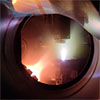| Apr 04, 2022 |
|
(Nanowerk News) Solar energy can directly drive electrochemical reactions at the surface of photoelectrodes. Photoelectrodes consist of semiconducting thin films on transparent conductive-glass substrates that convert light into electricity.
|
|
Most photoelectrochemical studies have focused on water splitting, a thermodynamically uphill reaction that could offer an attractive pathway for the long-term capture and storage of solar energy by producing ‘green’ hydrogen.
|
|
Metal-oxide thin film photoelectrodes are particularly interesting for these diverse functions. They comprise abundant elements, potentially offering infinite tunability to achieve the desired properties – at potentially low costs.
|
Made from plasma
|
|
At the HZB Institute for Solar Fuels, several teams focus on developing such photoelectrodes. The usual method to produce them is pulsed laser deposition: an intense laser pulse hits a target containing the material and ablates it into a highly energetic plasma deposited on a substrate.
|
 |
| Pulsed laser deposition: An intense laser pulse hits a target containing the material, tranforming it into a plasma which is then deposited as a thin film onto a substrate. (Image: R. Gottesman/HZB)
|
Quality needs heat
|
|
Further steps are needed to improve the quality of the deposited thin film. In particular thermal processing of the metal-oxide thin-film reduces defects and imperfections. However, this creates a dilemma: Reducing atomic defects concentration and improvements in crystalline order of the metal-oxide thin films would require thermal processing temperatures between 850 and 1000 degrees Celsius – but the glass substrate melts already at 550 degrees Celsius.
|
Flash-heating the thin film
|
|
Dr. Ronen Gottesman from the HZB Institute for Solar Fuels has now solved this problem: After deposition, using high-powered lamps, he flash-heats the metal-oxide thin film. This heats it up to 850 degrees Celsius without melting the underlying glass substrate (ACS Energy Letters, “Shining a Hot Light on Emerging Photoabsorber Materials: The Power of Rapid Radiative Heating in Developing Oxide Thin-Film Photoelectrodes”).
|
|
“The heat efficiently reduces structural defects, trap states, grain boundaries, and phase impurities, which would become more challenging to mitigate with an increasing number of elements in the metal-oxides. Therefore, new innovative synthesis approaches are essential. We have now demonstrated this on photoelectrodes made of Ta2O5, TiO2, and WO3, which we heated to 850 °C without damaging the substrates,” says Gottesman.
|
Record performance for α-SnWO4
|
|
The new method was also successful with a photoelectrode material that is considered a very good candidate for solar water splitting: α-SnWO4. Conventional furnace heating leaves behind phase impurities. Rapid thermal processing (RTP) heating improved crystallinity, electronic properties, and performance, leading to a new record performance of 1 mA/cm2 for this material, higher by 25% than the previous record.
|
|
“This is also interesting for the production of quantum dots or halide perovskites, which are also temperature-sensitive,” explains Gottesman.
|


